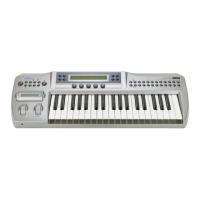•VALUE-
key,
VALUE+
key
In
Performance
mode,
these
keys select
the
program
to
play.
--7 p.9
When
writing
a
program,
these
keys select
the
writing
destination program. --7 p.31
n Define
and
Edit modes, these keys modify the value of the
parameter where the cursor is located.
-->
p.21
•EXIT
key
This key is used to exit the
current
mode
or function; such
as
moving
from
Performance
Editor
Define
or
Pattern
Define modes back to the
previous
mode,
moving
in
Edit
mode
to an
upper
level,
or
canceling
an
operation or setting
that you are being asked to confirm.
•PERFORMANCE/EDIT Select
key
This key switches the function of the keys located to its right,
alternating
between
the
Performance
mode
functions
(the
upper
LED
will light)
and
the Edit
mode
functions (the lower
LED will blink).
•A/OSC
key
•CARD/MIXER
key
•CARD
PAT/AMP
key
•PE2/EG
key
•PE4/COMMON
key
•B/W.SHAPE
key
•IN
PAT/FILTER
key
•PE1/EFFECT
key
•PE3/LFO
key
•PE
DEFINE/GLOBAL
key
These
keys
access
the
function
selected
by
the
PERFOR-
MANCE/EDIT Select key.
When the LED above the PERFORMANCE/EDIT Select
key
is lit (Performance mode),
these keys select the
Program
Bank (A,B,Card),
the
Arpeggiator Pattern Bank (IN PAT, CARD PAT),
turn
on/off
the Performance Editor (PEl, PE2, PE3, PE4),
and
enter Performance Edit mode.
When
the LED below the PERFORMANCE/EDIT Select key
is blinking (Edit mode),
o these keys access the
various
section
of
Edit
mode
(OSC, W.SHAPE, MIXER, FILTER, AMP, EFFECT,
EG,
LFO, COMMON, GLOBAL).
Pattern/Program
Select
key
•WRITE
key
This
key
writes
the
settings
of
the
currently
selected program. p.31
If
the
program
is
protected,
a
message
will
appear
and
the operation will be canceled.
•COMPARE
key
When
editing
program
parameters,
this
key
allows
you
to call
up
the original
values
of
the
program.
Alternatively,
if
you
have
not
yet
written
your
edits,
this
key
allows
you
to
audition
other
programs
without
losing
your
edits
(For example, to find
an
alternate
writing
destination). p.31
•ENTER
key
This
key
is
used
to
finalize
the
input
from
the
numeric keys, to confirm
when
writing
a
program
or
executing
a
utility
function.
When
you
have
made
a
change
that
requires
confirmation
or
execution, the
LED
will blink. p.21
This key is also used to finalize a selection in a
menu
page. (In this case the
LED
will not blink.)
--7 p.20
This key switches the function of the keys located to its right;
they
will
either
select
performance
mode
arpeggio
patterns
(the
upper
LED will blink)
or
act as
numeric
keys to select
programs (when the lower
LED
is lit).
When
Performance
Editor
Define,
Pattern
Define
mode,
or
Edit
mode
are selected, both will go off. In this case, the
keys act as
+I-
input
keys for the parameter value.
Both
LEDs
will also
be
off
when
waiting for a Program Write
operation to be executed. (In this case the keys located to the
right will not function
at
all.)
P/0
key
•ALT
1/2
key
•RANDOM/4
key
•PAT2/6
key
DOWN/1
key
•ALT
2/3
key
•PAT115
key
•PAT3/7
key
PAT4/8
key
•PAT5/9
key
These keys access
the
function selected
by
the
PATTERN I
PROGRAM Select key.
When the
LED
above the PATTERN/PROGRAM Select key is
blinking,
These keys select arpeggiator
patterns
(UP, DOWN,
ALT
1,
ALT
2,
RANDOM, PAT 1, PAT
2,
PAT 3, PAT
When
the
LED
below the PATTERN/PROGRAM Select
key
is lit,
The keys will act as numeric keys to select programs
9).
When both of the PATTERN/PROGRAM Select LEOs are off,
These
keys will
act
as
numeric
keys for
entering
parameter
values in Define
and
Edit modes.
3

